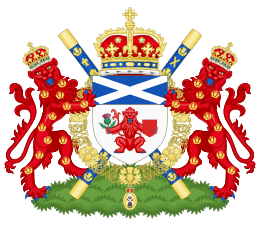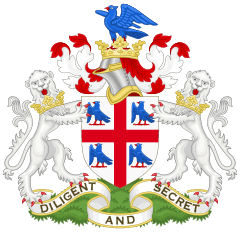Heraldic authority
For the purposes of this article, a heraldic authority is defined as an office or institution which has been established by a reigning monarch or a government to deal with heraldry in the country concerned. It does not include private societies or enterprises which design and/or register coats of arms.
Over the centuries, many countries have established heraldry authorities, and several still flourish today.
Europe


Belgium
- Raad van Adel or Conseil de la noblesse (Council of the Nobility) (1844– ) – grants arms to the nobility and municipal arms in the German Speaking Community of Belgium.
- Vlaamse Heraldische Raad (Flemish Heraldic Council) (1984– ) – grants non-noble personal, official, municipal, and corporate arms within the Flemish Community of Belgium.
- Conseil d'héraldique et de vexillologie de la Communauté française de Belgique (Heraldic and Vexilological Council of the French Community of Belgium) (1985– ) – grants non-noble personal and municipal arms in the French Community of Belgium.
Burgundy
- Toison d'Or King of Arms (1430–83)
Czech Republic
- Chamber of Deputies of the Parliament of the Czech Republic - Subcommittee on heraldry and vexillology
The subcommittee deals only with municipal heraldry and vexillology. The Czech Republic has no heraldic authority for personal arms.
Denmark
- Statens Heraldiske Konsulent (State Heraldry Advisor) (1938– )
France
- College d'armes (1407–1790)
Georgia
- State Council of Heraldry at the Parliament of Georgia (established in 2008)
Germany
Holy Roman Empire
- Reichsherold (Imperial Herald) (1520-?)
Bavaria
- Reichsherold (Royal Herald) (1808–1920)
Prussia
- Oberheroldsamt (1706–1713) – dealt with noble and municipal arms.
- Königlich Preussisches Heroldsamt (Royal Prussian Heraldry Office) (1855–1920)
Saxony
- Kommissariatt für Adelsangelegenheiten (Commission for Noble Affairs) (1902–1920)
Ireland
- Ulster Office (1552–1943), headed by Ulster King of Arms.
- Genealogical Office (1943– ), headed by the Chief Herald of Ireland and forming part of the National Library of Ireland – grants personal, official, municipal, and corporate arms.
Italy
- Consulta Araldica (Heraldry Council) (1869–1947)
- Ufficio Cerimoniale della Presidenza del Consiglio dei Ministri (since 1947) [1]
Latvia
- State Heraldry Commission (1997– ), forming part of the Presidency – deals with official and municipal arms.[2]
Lithuania
- Heraldry Commission (1988– ),[3] forming part of the Presidency – deals with official and municipal arms.
Luxembourg
- Commission héraldique de l'Etat (State Heraldic Commission)
Netherlands
- Hoge Raad van Adel (High Council of the Nobility) (1815– ) – grants personal arms (to nobles only) and official, military, and municipal arms.
Norway
- Ministry of Foreign Affairs - all matters concerning the Coat of arms of Norway (Norwegian: Riksvåpenet = Coat of arms of the realm)
Poland
- Komisja Heraldyczna (Heraldic Commission)
Portugal
- Gabinete de Heraldica Corporative (Office for Corporate Heraldry) (1930– ) – registers corporate arms.
- Gabinete de Heraldica Autarquica (Office for Municipal Heraldry) (1991– ) – registers municipal arms.[4]
Russia
- Office of Heraldry (1722–1917), headed by the Master Herald – granted personal, official, and municipal arms.
- Heraldic Council of the President of the Russian Federation or State Heraldry Service (1992– ), headed by the Master Herald and forming part of the President's Office.
Slovakia
- Heraldic Commission
- Heraldic Registry of the Slovak Republic (part of Ministry of Interior)
Spain
- Cronistas de Armas (Recorders of Arms), established in 1496. (For provinces of Castile and León only.)
Sweden
- Riksheraldiker (National Herald) (1734–1953)
- Statens Heraldiska Nämnd (State Heraldry Office) (1953– ), headed by a State Herald, and forming part of the Royal Archives. registered with the Swedish Patent and Registration Office (Patent- och registreringsverket or PRV). Only official arms (royal and civic arms) are handled. Burgher and commoner arms are less strictly controlled and may be recognized by publication in the annual Scandinavian Roll of Arms.
United Kingdom
England and Wales
- College of Arms (1484- ), headed by the Garter Principal King of Arms, under the general jurisdiction of the Earl Marshal – grants personal, municipal, and corporate arms, also records pedigrees and genealogies.
Northern Ireland
- Until 1943, Northern Ireland came under the Ulster Office; since then, it has fallen under the College of Arms part of the jurisdiction of the Norroy and Ulster King of Arms which also covers the counties of England and Wales North of the River Trent.
Scotland
- Court of the Lord Lyon, headed by the Lord Lyon – grants personal, municipal, and corporate arms; it is illegal to bear arms in Scotland unless they have been granted or recorded by the Lord Lyon.
Africa
Kenya
- Kenya College of Arms (1968– ), headed by a Registrar, and forming part of the Attorney-General's Office – grants and registers personal, municipal, and corporate coats of arms.
South Africa
- Department of the Interior (1935–1959) – inter alia registered the arms of associations and institutions, as "badges".
- Provincial administrations (1949–1963 – inter alia registered the arms of municipalities in their respective provinces.
- Department of Education, Arts & Sciences (1959–1963 – inter alia registered the arms of associations and institutions, as "badges".
- Bureau of Heraldry (1963– ), headed by the National Herald (formerly State Herald), and forming part of the National Archives & Records Service – registers personal, official, military, municipal, and corporate arms. Together with the Heraldry Council, it forms part of the National Archives and Records Service (formerly called the State Archives Service), which is currently under the authority of the Minister of Arts & Culture.
It should be noted that the Act governing the Bureau of Heraldry has not been changed to replace "State herald" with "National Herald". Announcements in the Government Gazette of South Africa still use "State Herald".
Zambia
- Colours Control Board (1958– ) – inter alia registers the arms of associations and institutions, as "badges".
Zimbabwe
- Registrar of Names, Uniforms, Badges and Heraldic Representations (1971– ), forming part of the Patents Office – registers official, municipal, corporate, and personal arms.
Asia
Azerbaijan
- Heraldic Council (2006– ), forming part of the Presidency.
North America and Caribbean
Antigua and Barbuda
- Antigua Herald of Arms (1998– ) and Barbuda Herald of Arms (1998– ) – established under the National Honours Act 1998.[5]
Canada
- Canadian Heraldic Authority (1988– ), headed by the Chief Herald of Canada, and forming part of the Governor-General's Household – grants personal, official, military, municipal, and official arms.
United States of America
- Carolina Herald was an English herald responsible for heraldry in Carolina in colonial times, early and mid 18th Century.
- United States Army Institute of Heraldry (1920– ) – responsible for military heraldry, also provides heraldic services to the federal government.
Oceania
New Zealand
- New Zealand Herald Extraordinary (1978– ) in the Governor-General's Household – represents the English College of Arms.
References
- ↑ Attribuzioni
- ↑ "State Heraldry Commission". Latvijas Valsts Prezidents. Retrieved 10 August 2014.
- ↑ Galkus, Juozas (2009). Lietuvos Vytis / The Vytis of Lithuania. Vilnius: Vilniaus dailės akademijos leidykla. p. 368. ISBN 9789955854449.
- ↑ http://www.heraldica.org/topics/national/portugal-municipal.htm
- ↑ National Honours Act 1998
- Canadian Heraldic Authority
- Chief Herald of Ireland
- College of Arms (England)
- Court of the Lord Lyon (Scotland)
- Hoge Raad van Adel (Netherlands)
- Staats Heraldiske Namnd (Sweden)
- Vlaamsche Heraldische Raad (Belgium)
- Von Volborth, C.A. Heraldry of the World. (1973)